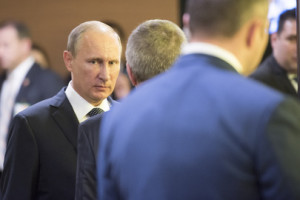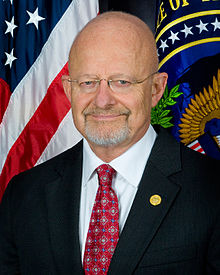US Report Still Lacks Proof on Russia ‘Hack’
by Robert Parry - Consortium News
January 7, 2017
 Repeating an accusation over and over again is not evidence that the accused is guilty, no matter how much “confidence” the accuser asserts about the conclusion. Nor is it evidence just to suggest that someone has a motive for doing something. Many conspiracy theories are built on the notion of “cui bono” – who benefits – without following up the supposed motive with facts.
Repeating an accusation over and over again is not evidence that the accused is guilty, no matter how much “confidence” the accuser asserts about the conclusion. Nor is it evidence just to suggest that someone has a motive for doing something. Many conspiracy theories are built on the notion of “cui bono” – who benefits – without following up the supposed motive with facts.Russian President Vladimir Putin, following address
to UN General Assembly -Sept. 28, 2015. (UN Photo)
But that is essentially what the U.S. intelligence community has done regarding the dangerous accusation that Russian President Vladimir Putin orchestrated a covert information campaign to influence the outcome of the Nov. 8 U.S. presidential election in favor of Republican Donald Trump.
Just a day after Director of National Intelligence James Clapper vowed to go to the greatest possible lengths to supply the public with the evidence behind the accusations, his office released a 25-page report that contained no direct evidence that Russia delivered hacked emails from the Democratic National Committee and Hillary Clinton’s campaign chairman John Podesta to WikiLeaks.
The DNI report amounted to a compendium of reasons to suspect that Russia was the source of the information – built largely on the argument that Russia had a motive for doing so because of its disdain for Democratic nominee Clinton and the potential for friendlier relations with Republican nominee Trump.
But the case, as presented, is one-sided and lacks any actual proof. Further, the continued use of the word “assesses” – as in the U.S. intelligence community “assesses” that Russia is guilty – suggests that the underlying classified information also may be less than conclusive because, in intelligence-world-speak, “assesses” often means “guesses.”
The DNI report admits as much, saying, “Judgments are not intended to imply that we have proof that shows something to be a fact. Assessments are based on collected information, which is often incomplete or fragmentary, as well as logic, argumentation, and precedents.”
But the report’s assessment is more than just a reasonable judgment based on a body of incomplete information. It is tendentious in that it only lays out the case for believing in Russia’s guilt, not reasons for doubting that guilt.
A Risky Bet
For instance, while it is true that many Russian officials, including President Putin, considered Clinton to be a threat to worsen the already frayed relationship between the two nuclear superpowers, the report ignores the downside for Russia trying to interfere with the U.S. election campaign and then failing to stop Clinton, which looked like the most likely outcome until Election Night.
Former Secretary of State Hillary Clinton
So, on top of Clinton’s well-known hawkishness, Putin would have risked handing the expected incoming president a personal reason to take revenge on him and his country. Historically, Russia has been very circumspect in such situations, usually holding its intelligence collections for internal purposes only, not sharing them with the public.
While it is conceivable that Putin decided to take this extraordinary risk in this case – despite the widely held view that Clinton was a shoo-in to defeat Trump – an objective report would have examined this counter argument for him not doing so.
But the DNI report was not driven by a desire to be evenhanded; it is, in effect, a prosecutor’s brief, albeit one that lacks any real evidence that the accused is guilty.
Further undercutting the credibility of the DNI report is that it includes a seven-page appendix, dating from 2012, that is an argumentative attack on RT, the Russian government-backed television network, which is accused of portraying “the US electoral process as undemocratic.”
The proof for that accusation includes RT’s articles on “voting machine vulnerabilities” although virtually every major U.S. news organizations has run similar stories, including some during the last campaign on the feasibility of Russia hacking into the actual voting process, something that even U.S. intelligence says didn’t happen.
The reports adds that further undermining Americans’ faith in the U.S. democratic process, “RT broadcast, hosted and advertised third-party candidate debates.” Apparently, the DNI’s point is that showing Americans that there are choices beyond the two big parties is somehow seditious.
“The RT hosts asserted that the US two-party system does not represent the views of at least one-third of the population and is a ‘sham,’” the report said. Yet, polls have shown that large numbers of Americans would prefer more choices than the usual two candidates and, indeed, most Western democracies have multiple parties, So, the implicit RT criticism of the U.S. political process is certainly not out of the ordinary.
The report also takes RT to task for covering the Occupy Wall Street movement and for reporting on the environmental dangers from “fracking,” topics cited as further proof that the Russian government was using RT to weaken U.S. public support for Washington’s policies (although, again, these are topics of genuine public interest).
Behind the Curtain
Though it’s impossible for an average U.S. citizen to know precisely what the U.S. intelligence community may have in its secret files, some former NSA officials who are familiar with the agency’s eavesdropping capabilities say Washington’s lack of certainty suggests that the NSA does not possess such evidence.
 For instance, that’s the view of William Binney, who retired as NSA’s technical director of world military and geopolitical analysis and who created many of the collection systems still used by NSA.
For instance, that’s the view of William Binney, who retired as NSA’s technical director of world military and geopolitical analysis and who created many of the collection systems still used by NSA. Binney, in an article co-written with former CIA analyst Ray McGovern, said, “With respect to the alleged interference by Russia and WikiLeaks in the U.S. election, it is a major mystery why U.S. intelligence feels it must rely on ‘circumstantial evidence,’ when it has NSA’s vacuum cleaner sucking up hard evidence galore. What we know of NSA’s capabilities shows that the email disclosures were from leaking, not hacking.”
James Clapper, Director of National Intelligence
There is also the fact that both WikiLeaks founder Julian Assange and one of his associates, former British Ambassador Craig Murray, have denied that the purloined emails came from the Russian government. Going further, Murray has suggested that there were two separate sources, the DNC material coming from a disgruntled Democrat and the Podesta emails coming from possibly a U.S. intelligence source, since the Podesta Group represents Saudi Arabia and other foreign governments.
In response, Clapper and other U.S. government officials have sought to disparage Assange’s credibility, including Clapper’s Senate testimony on Thursday gratuitously alluding to sexual assault allegations against Assange in Sweden.
However, Clapper’s own credibility is suspect in a more relevant way. In 2013, he gave false testimony to Congress regarding the extent of the NSA’s collection of data on Americans. Clapper’s deception was revealed only when former NSA contractor Edward Snowden leaked details of the NSA program to the press, causing Clapper to apologize for his “clearly erroneous” testimony.
A History of Politicization
The U.S. intelligence community’s handling of the Russian “hack” story also must be viewed in the historical context of the CIA’s “politicization” over the past several decades.
Then-Vice President George H.W. Bush and CIA Director William Casey
in the White House Feb. 11, 1981. (Photo: Reagan Library)
U.S. intelligence analysts, such as senior Russia expert Melvin A. Goodman, have described in detail both in books and in congressional testimony how the old tradition of objective CIA analysis was broken down in the 1980s.
At the time, the Reagan administration wanted to justify a massive arms buildup, so CIA Director William Casey and his pliant deputy, Robert Gates, oversaw the creation of inflammatory assessments on Soviet intentions and Moscow’s alleged role in international terrorism, including the attempted assassination of Pope John Paul II.
Besides representing “politicized” intelligence at its worst, these analyses became the bureaucratic battleground on which old-line analysts who still insisted on presenting the facts to the president whether he liked them or not were routed and replaced by a new generation of yes men.
The relevant point is that the U.S. intelligence community has never been repaired, in part because the yes men gave presidents of both parties what they wanted. Rather than challenging a president’s policies, this new generation mostly fashioned their reports to support those policies.
The bipartisan nature of this corruption is best illustrated by the role played by CIA Director George Tenet, who was appointed by President Bill Clinton but stayed on and helped President George W. Bush arrange his “slam dunk” case for convincing the American people that Iraq possessed caches of WMD, thus justifying Bush’s 2003 invasion.
There was the one notable case of intelligence analysts standing up to Bush in a 2007 assessment that Iran had abandoned its nuclear weapons program, but that was more an anomaly – resulting from the acute embarrassment over the Iraq WMD fiasco – than a change in pattern.
Presidents of both parties have learned that it makes their lives easier if the U.S. intelligence community is generating “intelligence” that supports what they want to do, rather than letting the facts get in the way.
The current case of the alleged Russian “hack” should be viewed in this context: President Obama considers Trump’s election a threat to his policies, both foreign and domestic. So, it’s only logical that Obama would want to weaken and discredit Trump before he takes office.
That doesn’t mean that the Russians are innocent, but it does justify a healthy dose of skepticism to the assessments by Obama’s senior intelligence officials.
[For more on this topic, see Consortiumnews.com’s “Escalating the Risky Fight with Russia” and “Summing Up Russia’s Real Nuclear Fears.”]
Investigative reporter Robert Parry broke many of the Iran-Contra stories for The Associated Press and Newsweek in the 1980s. You can buy his latest book, America’s Stolen Narrative, either in print here or as an e-book (from Amazon and barnesandnoble.com).



No comments:
Post a Comment